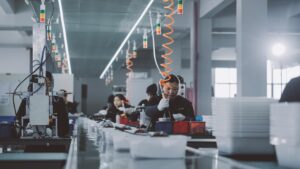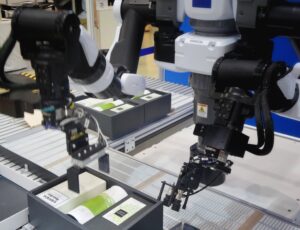The landscape of industrial automation has been continually evolving, with advancements in technology driving efficiency, precision, and customization. One technology that has emerged as a game-changer in this realm is 3D printing. This revolutionary technique, also known as additive manufacturing, has transformed the way industries produce parts and components. In this article, we will delve into the profound impact of 3D printing on industrial automation, exploring its benefits, applications, and the future it promises.
The Foundation of 3D Printing
1.1. Understanding Additive Manufacturing
At its core, 3D printing is a process that builds three-dimensional objects layer by layer from a digital model. This stands in stark contrast to traditional subtractive manufacturing, which involves cutting away material from a solid block. The additive nature of 3D printing not only reduces waste but also opens up new design possibilities, allowing for intricate and complex geometries that were once deemed impractical or impossible.
1.2. Types of 3D Printing Technologies
Several technologies fall under the umbrella of 3D printing, including Fused Deposition Modeling (FDM), Stereolithography (SLA), Selective Laser Sintering (SLS), and more. Each of these employs distinct methods and materials, catering to a wide range of applications across industries.
Tech@Levintutu is the technical team at @Levintutu who writes on the latest technology and its applications in industrial automation. To read more about us, visit our case studies at https://levintutu.com/case-study/.
Empowering Industries through 3D Printing
2.1. Tailored Components for Enhanced Performance
One of the paramount advantages of 3D printing in industrial automation is the ability to create bespoke components. Manufacturers can design and produce parts precisely tailored to the specific requirements of a given application. This level of customization leads to enhanced performance, increased efficiency, and improved overall system functionality.
2.2. Rapid Prototyping and Iteration
Traditionally, the prototyping process was a time-consuming and expensive endeavor. With 3D printing, however, companies can now rapidly prototype designs and iterate on them within a matter of hours. This accelerated development cycle allows for quicker product refinement and ultimately shorter time-to-market.
Redefining Supply Chains and Logistics with 3D Printing
3.1. On-Demand Manufacturing
It facilitates on-demand manufacturing, wherein products are produced as and when they are needed. This paradigm shift reduces the need for extensive warehousing and minimizes excess inventory, resulting in cost savings and a more streamlined supply chain.
3.2. Localization of Production
Global supply chain disruptions, as witnessed during the COVID-19 pandemic, have underscored the vulnerability of relying on distant manufacturers. 3D printing enables localized production, allowing companies to manufacture closer to their end-users. This not only mitigates supply chain risks but also reduces transportation emissions and costs.
Complexity at No Extra Cost
4.1. Intricate Geometries and Assemblies
It is not bound by the same constraints as traditional manufacturing methods. It excels in producing complex geometries and assemblies that would be impractical or impossible to create using conventional techniques. This opens up new design possibilities, allowing engineers to push the boundaries of what is achievable.
4.2. Consolidation of Parts
In many cases, it enables the consolidation of multiple components into a single, more streamlined part. This not only reduces assembly time but also eliminates potential points of failure, leading to more robust and reliable products.
Sustainable Manufacturing Practices
5.1. Material Efficiency and Waste Reduction
Unlike subtractive manufacturing, which often generates significant waste, 3D printing is remarkably efficient in its use of materials. Additive processes deposit material only where needed, minimizing excess and reducing overall waste. Additionally, many materials are recyclable, further contributing to sustainability efforts.
5.2. Localized Production and Reduced Transportation
By enabling localized production, it significantly cuts down on the need for long-distance transportation of goods. This leads to a reduction in carbon emissions and a smaller environmental footprint, aligning with global efforts to combat climate change.
To read about How Video Analytics is Revolutionizing Industrial Automation visit our blog Discover How Video Analytics is Revolutionizing Industrial Automation
Conclusion: A New Era in Industrial Automation
The integration of 3D printing into industrial automation marks a transformative shift in manufacturing paradigms. Its capacity for customization, rapid prototyping, and sustainable practices reshape the way industries operate. As technology continues to evolve, we can anticipate even greater strides in efficiency, cost-effectiveness, and innovation. Embracing 3D printing is not just an option; it’s a necessity for industries striving to stay at the forefront of automation in the 21st century.
In conclusion, 3D printing has ushered in a new era of possibilities for industrial automation. Its ability to customize, streamline supply chains, handle complexity, and promote sustainability are all key factors in its revolutionizing impact. As we move forward, the synergies between 3D printing and industrial automation are bound to drive even more innovations, reshaping the landscape of manufacturing for years to come.
This article provides an in-depth look at Revolutionizing Industrial Automation with 3D Printing and the benefits it brings to various industries. Depending on your target audience, you might want to include specific case studies or examples of successful implementations in different sectors.
To stay updated with our latest innovations and explore how our AI-led automation can revolutionize your enterprise-wide processes, visit our website and follow us for exciting developments in the world of robotics and data analytics: https://levintutu.com/
And Follow us at https://www.linkedin.com/company/levintutu-automation/.



